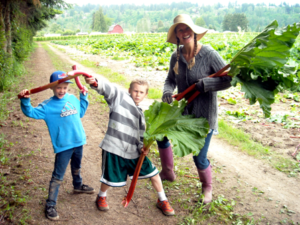How Can We Help?
School Garden Construction with Okanogan County Community Action Council
You are here:
< All Topics
The East Omak School Garden has a couple of great components which can be outlined as follows:
- Thr
 ee raised vegetable beds using compost and cinder blocks. These beds are not large enough to produce food for the school, so they are used as experiment beds to demonstrate different controls: Half compost, half no compost, etc.
ee raised vegetable beds using compost and cinder blocks. These beds are not large enough to produce food for the school, so they are used as experiment beds to demonstrate different controls: Half compost, half no compost, etc.  Raspberry patch.
Raspberry patch.- Six different compost bins, and a compost tumbler. The compost bins are made to look like apple bins, and were constructed using scrap lumber. The compost tumbler was donated by OCCAC in 2011. Omak High School donates its shredded paper, and the East Omak Elementary School Cafeteria pools its kitchen waste to be brought out to the compost bins. The objective is to get the kids to put their green food scraps in a separate container as well in order to capture the majority of the green, compostable waste that is produced by the school. The compost bins also have large populations of compost worms that are used for vermiculture experiments inside of the classroom, during the fall and winter months.
- Underground Stash. Modeled after the book, Buffalo Bird Woman’s Garden, encourages students to think about extending the harvest of their root crops, through the snows of the winter, and into the spring. The insulation of the hay and the simple plywood lid on the stash hole keeps potatoes and carrots safe through winter snows, and in spring, the students are able to bring home part of the harvest.
- In 2012, OCCAC built a perennial pollinator “Wild Zone” bed on the school garden site. The Wild Zone doubled the size of the garden, and was expanded on existing school grass. Sheet mulching techniques were used, utilizing donated cardboard, manure, straw, compost and wood chips. (For some ideas on where to find these items, consider warehouses, stables, feed lots, and tree-trimming services.) The sheet mulch was contoured with swales for water conservation, and native ground cover, shrubs and bushes were added at intervals which considered their size at maturity; as these plants reach maturity, they will provide year round food and habitat for birds, pollinators and predatory insects, they will act as Nitrogen-Fixers for the soil, and they will shed their leaves on the top of the soil. While the native shrubs mature, self-seeding annual flowers are transplanted into the bed. The intent in designing a Wild Zone was to demonstrate ecological aspects of gardening beyond row crops in raised beds, and perhaps, eight years down the road, provide an excellent hide-and-seek spot. The total cost of the projects was about $60 for the native plants [purchased in bulk], and about $15 for drip irrigation; everything else was scrounged, donated or volunteered.
- A curriculum has been established to provide something to integrate into regular class activities throughout the year, and in the future, an After-School Program will not be necessary. Cathy Darley, the teacher in charge of the East Omak Garden will limit garden engagement to those students in her class that wish to help with composting, propagation and decomposer / ecological education, and a garden club for students that wish to help with planting, transplanting, harvest and seed collection.


